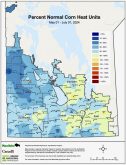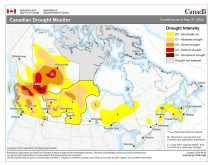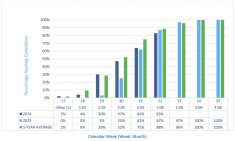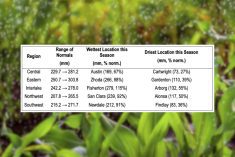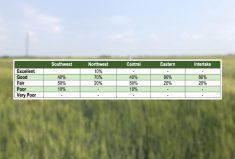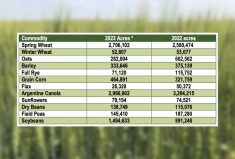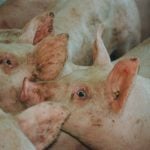Despite the wet conditions, seeding progress was made throughout much of the province last week and is estimated to be 92 per cent complete. Spring cereals, peas, and grain corn are approximately 97 per cent complete. Canola and soybean planting advanced, with 88 per cent of canola acres and 92 per cent of soybean acres planted. Many of the unseeded acres are expected to be planted to canola. Herbicide applications are on-going, and growers continue to monitor fields for flea beetles.
Cereals
Most of the fall rye is at full head emergence, and winter wheat is in late boot to early head emergence.
Read Also

Seeding Indigenous agricultural prosperity
National Circle for Indigenous Agriculture and Food says Indigenous agricultural success needs strong relationships.
Spring wheat seeding is at 98 per cent complete, barley and oats are 97 per cent complete across the province.
Most early seeded spring wheat is in the 3 to 5 leaf stage and tillering.
Grain corn planting is 98 per cent complete with most of the early planted corn at V3 to V6 stage.
Herbicide applications are ongoing.
Oilseeds
Canola planting is 88 per cent complete across the province, with the most advanced canola in the 2 to 4 leaf stage.
Sunflower planting is at 61 per cent completion across the province, with the earliest seeded sunflowers at the cotyledon to first true leaf stage.
Flax is at 76 per cent completion across the province with most emerged. The most advanced flax has 2 pairs of true leaves.
Flea beetle activity has increased in some areas, and some foliar insecticide applications have been conducted.
Pulses and Soybeans
Field pea planting is at 97 per cent completion across the province, with most fields in the 3 to 6 node stage.
Soybean planting is at 92 per cent completion across the province, with the most advanced fields at the first trifoliate stage.
Dry bean planting is at 86 per cent completion across the province.
Forages and Livestock
Forages
Hay and pasture fields are rapidly growing with good moisture conditions, but warmer weather will aid in faster growth. Many low spots still have standing water.
Bromes and ryegrasses are tillering to heading. Alfalfa is in late bud to early flowering. Tame hay and alfalfa growth is now up to more than 26 inches.
Silaging has begun for dairy producers.
Livestock
Most cattle are on pasture and are making the most of strong pasture growth due to the moist soil conditions.
In areas with heavy rainfall, pastures are saturated or have standing water, and cattle are being moved to higher ground in areas where they may cause damage on waterlogged soils.
Breeding season has begun on some farms, with bulls being placed with cow herds.
Producers are checking their fences and carrying out necessary maintenance work ahead of the grazing
season. Cattle vaccination is underway. Calving has all but wrapped up.
Producers are attempting to control fly numbers on pasture and are looking for pink eye and foot rot where conditions remain wet underfoot.
Dugouts are full.
Regional Comments
Southwest
Temperatures have been variable during the week, with average temperatures ranging from 12 to 15 C. Growing degree days (GDD) and Corn Heat Units (CHU) are slightly below normal for this time of year. Wind damage to some crops has been reported, especially in lighter soils. Moisture conditions are normal to above normal. There is standing water in low areas of fields, but no major damage to the crops has been reported.
Seeding is 95 per cent complete, with some areas still reporting some canola to be planted as well as some greenfeed acres. Emergence is good in most areas and for most crops. Most cereals are in the 3 to 5 leaf stage and tillering. Peas are in the 3 to 6 node stage. Soybeans are emerging to the first trifoliate, with reports of wind damage. Canola is emerging to 2 to 3 leaves. Some flea beetle damage is beginning; however, little to no spraying has been done. Cool, windy conditions have slowed corn and sunflower development.
Herbicides are being applied in most areas, weather permitting, with about 25 per cent completion on average for the region. Windy conditions have made it difficult to spray. Some reports of cutworm damage in canola have been received. Producers are scouting and planning to spray for control. Diamondback moth and flea beetle numbers are low in the region so far.
Northwest
Cool, cloudy and windy conditions for most of the week along with scattered showers. Warm temperatures would benefit established crops as well as dry out fields that are too wet. Seeding is continuing where possible, with some acres being seeded around potholes. Strong winds have been a challenge for herbicide application. There are some reports of poor germination and soil crusting. Evidence of moisture stress in some crops in standing water.
Winter wheat and fall rye have begun heading. Approximately 92 per cent of spring wheat is seeded and the earliest seeded wheat is tillering. Some in-crop herbicide applications as appropriate stages are reached.
Canola seeding is ongoing. Canola is approximately 80-85 per cent complete, with further progress in the Roblin and Swan River areas. Stages of canola are varied due to the challenges of seeding this spring. Most advanced canola is at the 2 to 4 leaf stage. Flea beetle activity has increased and additional control has been required. There has been some reseeded canola due to damage.
Soybean crops continue to emerge and most advanced soybeans are in the unifoliate stage. Field pea seeding is complete and most fields have emerged.
Central
The week was cool, windy and cloudy with scattered showers. The most rain fell in the central part of the region, the northwest and southeast of the central region received less precipitation. Planting progressed rapidly this past week due to high winds allowing soils to dry sufficiently for planting and other field operations to take place. There is still water in low spots in some fields, with crops undergoing visible water stress. The cooler temperatures are slowing crop growth, and many crops are more advanced developmentally than they may at first appear given their height.
Spring wheat, barley and oat seeding is complete. Cereals are tillering, with in crop herbicide applications taking place as conditions allow. Fall rye is headed out and winter wheat is at the booting stage. Field peas have emerged, with most between the 3 to 6 node stage. Soybeans are 95% planted, with most emerged to the unifoliate stage. Much edible bean planting occurred over the week, with 95% now planted. Canola is at 95 per cent complete, with most between the cotyledon and the first true leaf stage. Flax planting is complete, with most of the crop emerged. Sunflower seeding progress is complete, with most from the cotyledon to first true leave stage. Silage and grain corn is complete, with most at 3 to 6 leaf stage.
The stage of each crop varies greatly, with crops around the RM of Portage la Prairie generally at a younger developmental stage than crops in the southeast of the region which are the most advanced, especially in the RMs of Rhineland, Montcalm, and Stanley. Weeds continue to appear as ample moisture has aided germination; however, the cold weather has slowed the speed of weed growth and development. Herbicide applications and spot spraying are taking place to control weeds at the desired growth stage, but this has been challenging at times with persistent high winds and regular rainfall. The high winds have resulted in some drift issues on emerged crops.
Both striped and cruciferous flea beetles are consuming canola seedlings, which in some cases has met the threshold for foliar insecticide applications. Cool temperatures are also keeping canola in the vulnerable stages longer than usual. Cutworms are sporadically affecting canola and sunflower crops, at times meeting the threshold for spraying. Diamondback moths have been found at moderate levels in monitoring traps across the central region, with Rosenfeld seeing the largest overall cumulative count in Manitoba. Grasshopper nymphs have emerged. A small number of seed corn maggots have been reported in sunflowers, but no serious damage.
Tan spot is appearing in wheat fields, likely supported by the cool, damp weather this spring.
Eastern
Rainfall accumulations ranged from less than 10 mm to over 25 mm with the bulk of the rain falling last Tuesday. The highest accumulations tended to occur in central and southern districts and varied from heavy downpours to light drizzle. Nighttime temperatures were cool resulting in slower crop emergence, particularly for warm season crops. Reduced heat accumulation has slowed plant development as well. Standing water persists in many fields across the region and some cereal crops continue to show yellowing in low areas.
With the additional rainfall, producers struggled to make progress on seeding, spraying and field work activities. Seeding resumed toward the end of the week and over the weekend, but conditions were not ideal with producers working around wet areas of fields and monitoring their land carefully to not miss any opportunities. At this point many producers expect some unseeded acres to remain. Fields are being harrowed multiple times and, in some cases, crop residues like corn stover are being burnt off to speed soil drying.
Fall rye is at partial to full head emergence. Winter wheat ranged from late boot to early head emergence. Crop conditions were rated as good overall. Spring seeding is around 80 per cent complete across the region although individual producer progress varies from some not started to others finished and well into herbicide applications. Approximately 95 per cent of spring wheat and oats are seeded, and approximately 15 to 20 per cent of early seeded spring wheat has received a first pass of herbicide. Early seeded wheat is in the four-leaf stage with two or three tillers and in good condition. Grain corn planting is complete with unseeded acres being switched to other crop types. Some early seeded corn is at the V2 stage. Corn herbicide applications have begun.
Approximately 90 per cent of soybean acres have been planted as producers rushed to finish before MASC seeding deadlines. Remaining acres will be switched to other crop types if weather allows. Relatively slow emergence and stand losses due to seedling disease have been noted on some early planted soybean fields. About 80 per cent of canola acres were planted with further canola seeding becoming a major focus of growers this week. Early seeded soybeans were in the cotyledon to unifoliate leaf stage while canola ranged from emergence/cotyledon to the first true leaf stage. A very limited amount of herbicide applications on soybeans and canola had occurred. Sunflower planting is complete with unseeded acres being switched to other crop types if weather allows. Total canola acres are expected to increase with producers and agronomists viewing canola as the go to switch crop for unseeded acres. A limited amount of insecticide application to control flea beetles on early seeded canola continues to occur. Early seeded field peas ranged from 3 to 5 nodes as growers were making every effort to apply herbicides before the crop was beyond stage. Flax crop growth stage ranged from cotyledon to the first and second pairs of true leaves unfolding.
Interlake
Scattered showers and thundershowers continued this past week, with variability in rainfall amounts across the Interlake region. Excess water stress on crops has been reported in some areas. Winds have continued to be strong, drying out the soil surface and interfering with spraying operations.
Seeding conditions were not ideal due to wet fields, with standing water in low areas. Limited seeding progress across the region last week but seeding resumed this Monday. Some producers are seeding around potholes and wet areas, broadcasting seed and harrowing. Seeding in the region is estimated to be 79 per cent complete. The South Interlake area is estimated to be 85-90 per cent complete, while the North Interlake is approximately 35-50 per cent complete.
Cereal crops are estimated at 90 per cent complete in the South Interlake and 70 per cent complete in the North Interlake. Most early seeded spring wheat is in the 2 to 4 leaf stage, and starting to tiller, with some as advanced as 5 to 6-leaf. Oats and barley are at similar leaf stages. Peas are estimated to be 65 per cent complete and are as advanced as the 3rd to 4th node. Grain corn is about 95 per cent complete in most parts of the Interlake region and is at V2 to V3.
Canola is estimated to be 40 per cent complete. Canola is in cotyledon to 2 leaf stage, with some fields more advanced, and many fields have uneven germination. Soybeans are estimated to be 40 per cent complete, and most are in the cotyledon to unifoliate stage. The most advanced fields are in the early 2nd trifoliolate. Sunflowers are estimated to be 50 per cent complete and have emerged. Flax has emerged and the stands look great.
Some reseeding of canola in the South Interlake. Reseeding is not as widespread as expected but fields continue to be monitored for moisture stress and uneven emergence.
Weed pressure is high due to wet conditions. Spraying continues to be a challenge due to strong winds and wet field conditions and progress for some has been limited. Spot spraying continues in wild oat patches in canola and soybean fields. Herbicide applications on wheat and corn have started in the last couple days in the South Interlake area.
Diamondback moth trap numbers are moderate, but variable due to the fluctuating temperatures and winds. True armyworm counts remain low in the South Interlake area. There is low flea beetle pressure in the region but fields are being closely monitored. No reports of spraying for flea beetles in early seeded canola. Producers are encouraged to scout their fields for flea beetle pressure.



